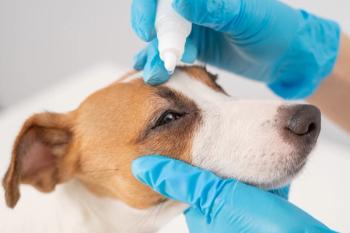Stage B1 and B2
Stage B1 is classified by asymptomatic disease with none to minimal remodeling present yet something abnormal appears on the physical exam, which then should prompt you to stage the disease, according to Estrada.
“The reason I have to stage it is because I’m trying to decide: is [the dog] very, very early in the course of his disease where [it’s] a B1 and [it] doesn’t have any structural remodeling, or is [the dog] at the phase where he’s a B2 and I now have clinical trial evidence that tells me if I start to treat X at this stage B2, I will make an extreme difference in that dog’s long term survival and quality of life,” she emphasized.
Meanwhile in the B2 stage, the disease is asymptomatic as well, however it is established that significant remodeling is apparent, so the pet is ready for therapy.
“B2s, these are the dogs or cats, where you heard something on your physical exam, you now looked at some kind of imaging modality and found that there is structural remodeling, so you are going to classify that patient and he is ready for therapy,” Estrada said.
Stage C
Stage C is when the clinical signs of heart disease the pet has been screening for begin to appear, therefore specific therapy and follow up are now required.
Some shared clinical signs of heart disease in dogs and cats include1,2,3:
- Weakness/collapse
- Lethargy
- Increased respiratory rate and effort
- Coughing
- Abdominal swelling
Stage D
According to Estrada, the main priority of this last stage is to best retain the pet’s quality of life and discuss end-of-life care considerations with the pet parent. Symptom-specific therapy and follow up are required as well.
“Stage D is where I kind of shift my brain and I’m no longer just thinking about heart failure, I’m thinking about quality of life…those are those pets that are refractory to standard treatment, they’re requiring frequent visits to the hospital…but my brain starts to switch to quality of life and hospice care,” she explained.
References
- Diagnosis of cardiovascular disease in dogs. Merck manual veterinary manual. Accessed Novmeber 4, 2021. https://www.merckvetmanual.com/dog-owners/heart-and-blood-vessel-disorders-of-dogs/diagnosis-of-cardiovascular-disease-in-dogs
- Llera R, Ward E. Heart disease in cats. Veterinary Centers of America, Inc. Accessed November 4, 2021. https://vcahospitals.com/know-your-pet/heart-disease-cardiomyopathy-in-cats
- Ruotsalo K, Tant MS. Testing for abdominal enlargement in cats. Veterinary Centers of America, Inc. Accessed November 4, 2021. https://vcahospitals.com/know-your-pet/testing-for-abdominal-enlargement-in-cats





